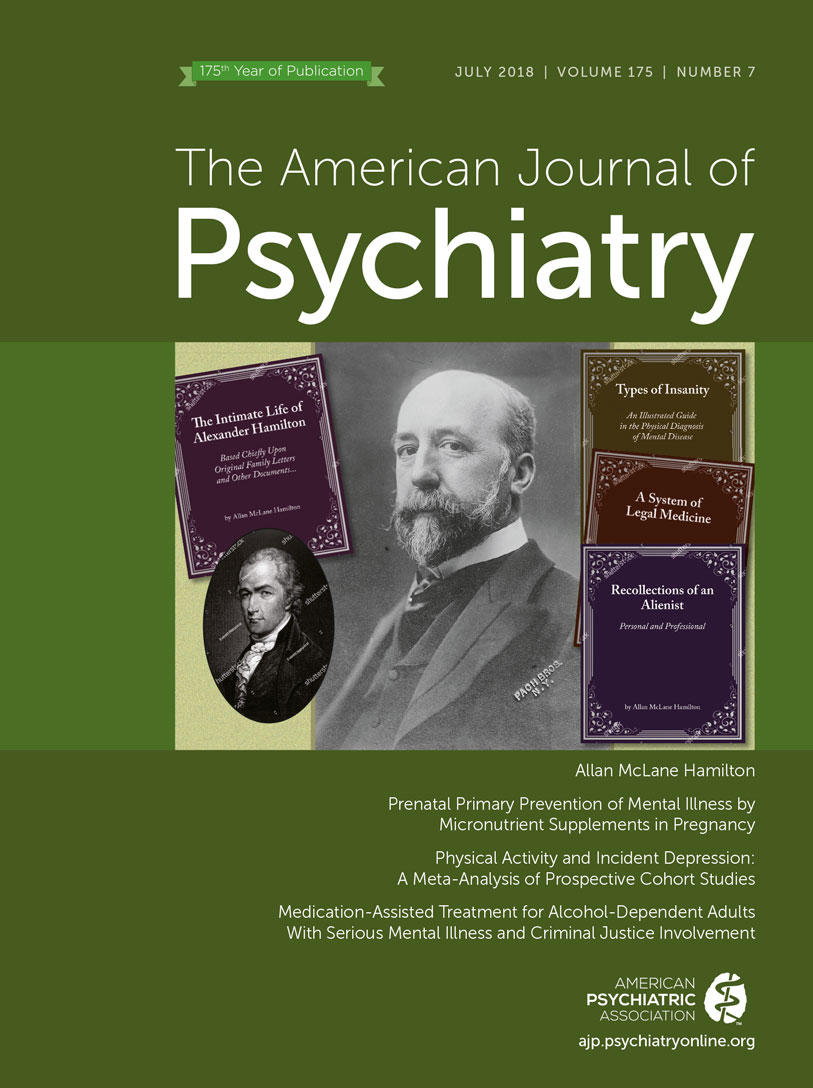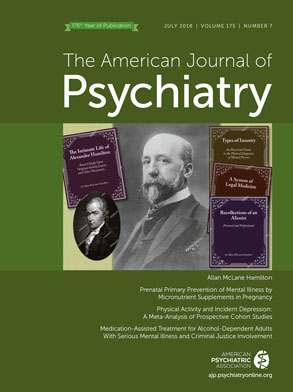Pharmaceutical industry scientists have begun studies to support approval for general clinical use of intranasal esketamine for treatment-resistant or acutely suicidal patients with major depression. An initial randomized, placebo-controlled phase 2 trial of intranasal esketamine for treatment of acutely suicidal patients was recently conducted by Canuso et al. and is reported in the
Journal (
1). Patients in the study were rated as imminently at risk for suicide and in need of hospitalization. Although suicidal ideation generally decreases transiently after interventions for attempted or imminent suicide, many patients will make another attempt within a year. Therefore, more effective therapies are needed.
In the Canuso et al. study, esketamine administered twice weekly intranasally along with antidepressant treatment at optimal dosages decreased suicidal ideation and depression at 4 and 24 hours, but the effect did not exceed that of intranasal placebo with antidepressant treatment at the 4-week endpoint of treatment. These acute effects of intranasal esketamine are similar to those achieved with intravenous ketamine (
2).
A phase 2 trial is an intermediate step in drug development. Phase 1 establishes that adequate levels of the drug can be safely administered to healthy subjects. Phase 2 identifies a range of suitable patients as well as safe and effective dosages to treat their conditions. Phase 3, the final phase that leads to U.S. Food and Drug Administration (FDA) approval for marketing, then proves that the drug is safe and effective in larger groups of patients. If positive, longer-duration results emerge for intranasal esketamine, it is possible that this treatment will help a significant number of patients who do not respond adequately to existing antidepressant therapies.
The history of pharmacology includes many life-saving drugs. However, it is also replete with examples of drugs whose abuse has outweighed their intended therapeutic effect. The most recent example is oxycodone, which was developed as an alternative to older abused opioids and then heavily promoted to protect patients from pain after medical and dental procedures. The abuse of oxycodone, with generalization to both fentanyl and heroin, has led to a national epidemic of opioid-caused deaths. The steps in the development of the epidemic are clear in hindsight. Initial promotion by the pharmaceutical company included vigorous marketing efforts to make physicians, nurses, dentists, and hospitals aware of their patients’ pain as a neglected medical symptom. The message to health care providers became to prescribe drug in amount and duration that would be more than sufficient to prevent pain. Asking patients to tolerate any pain was viewed as substandard practice. The prevention of abuse was seldom raised as a concern, and when it was, the onus was on the physician to detect and treat it. Fueling the epidemic was irresponsible distribution of large amounts of oxycodone, often thousands of prescriptions to individual pharmacies that served areas where diversion to abuse had become rampant. Congressional action prohibited regulation of this flow of drugs, despite warnings in 2003 from the Department of Justice (
3).
Ketamine drug-seeking behavior has already appeared as a clinical issue, with some patients shopping infusion clinics to obtain repeated injections for mood elevation. Some patients use the intravenous formulation intranasally repeatedly without supervision (
4). Diversion of ketamine intended for pediatric and veterinary anesthesia, its current approved use, is occurring already. Nonetheless, as in the case of oxycodone, the onus remains on individual physicians to assess appropriate use and to avoid creating dependence and abuse. The current American Psychiatric Association consensus statement (
5) is an example: “Considering the known potential for abuse of ketamine and recent reports of abuse of prescribed ketamine for the treatment of depression, clinicians should be vigilant about assessing the potential for patients to develop ketamine use disorder.” Concern about the deleterious effects of abuse with ketamine is all the more warranted given that most clinical trials have only examined acute safety and efficacy. Canuso et al. observed an attenuation of ketamine-specific clinical response over time; the failure to demonstrate longer-term benefits raises questions about the risk versus the benefit of long-term use.
The right and responsibility of physicians to administer the best care for their individual patients is a fundamental principle of health care ethics. Just as it is considered irresponsible to ask patients to tolerate pain, it is irresponsible to deny a suicidal patient the fullest range of effective interventions. To manage a difficult clinical situation, physicians can decide that a drug’s recommended limits for dosage, frequency, or duration of treatment can be superseded. However, the protection of the public’s health is part of our responsibility as well, and as physicians, we are responsible for preventing new drug epidemics. The mandate to individual physicians to prevent abuse has proven to be inadequate as the sole safeguard against the opioid epidemic, which has caused more morbidity and mortality than the postprocedure pain prevented by these medications. Paradoxically, methadone and clozapine, drugs with unique, proven therapeutic value, have very strict regulatory constraints on their use. Rather than wait until ketamine reaches widespread clinical use to see if it should be similarly regulated, it would be wise for physicians, regulatory agencies, and the pharmaceutical industry to work together preemptively to establish a suitable framework for its therapeutic use.
Ketamine has a well-known potential for tolerance and self-administration in animal models of addictive behavior (
6). In order to obtain FDA approval for marketing, phase 3 trials need to include rigorous monitoring of patients’ craving after ketamine administration and urine monitoring before each subsequent administration to detect evidence of drug seeking from other sources. No such monitoring has been done in the phase 2 trials reported to date. The incidence of early signs of abuse, although expected to be low within a controlled clinical trial environment, is a necessary baseline against which to compare less controlled administration in clinical practice. Phase 3 trials should also monitor patients for at least 8 weeks after the active phase of drug administration to detect the possible onset of new drug-seeking behavior.
Twice-weekly administration of ketamine has already been shown to be as effective as more frequent administration (
5). Since the urinary excretion of ketamine and its metabolite is mostly complete by 48 hours after administration, it would be desirable to establish a system similar to that currently used for laboratory monitoring of clozapine neutropenia, where prescription and dispensing would require documented laboratory evidence of a urinary level below a threshold, established in the phase 3 trials, that indicates no recent abuse.
A system similar to that used for methadone would offer an additional layer of protection. Limitation to authorized hospital pharmacies for inpatients and to authorized clinics for other patients would help prevent diversion by physicians and facilities unable to contain its use. In this model, intranasal ketamine would never be given to patients outside the clinic; rather, the medication would remain in the possession of the physician, only to be administered to the patient in the clinic as part of care for severely depressed patients. A national registry would enable physicians to detect patients who seek ketamine from multiple sources and might also serve as a research base for the assessment of effectiveness (
7).
Emergency medicine colleagues, once among the most frequent prescribers of oxycodone, have created programs that have significantly decreased its use. Their current statement on the use of ketamine does not address its use for suicidality (
8). It would be timely for emergency psychiatrists to help determine the extent to which, if any, ketamine should be used for suicidal patients to allow them to be discharged directly from emergency departments to outpatient treatment or whether patients whose suicidality warrants ketamine treatment also need to be hospitalized and receive ketamine treatment in that setting. Young, poor females, who may not have access to continuing mental health treatment, are disproportionately represented among suicide attempters. Off-label use of ketamine in adolescents should be restricted until there are adequate data on the drug’s developmental effects, including the development of addictive behavior. Many treatment-resistant depressed patients are already abusing substances that can interact with ketamine, including stimulants, opioids, and alcohol. Such patients were excluded from the Canuso et al. trial. However, potential interacting addictive effects with ketamine need to be assessed.
The FDA and the pharmaceutical companies marketing ketamine have the primary ability to control how the drug is distributed and in what circumstances it can be used, but input from psychiatrists and other interested professional groups as well as the Centers for Disease Control and Prevention and the National Institute on Drug Abuse, should inform the development of effective controls. Education of the public and physicians needs to balance both potential benefits and the risk of abuse. Because of the worldwide distribution of pharmaceuticals, coordination with regulatory agencies in other countries is essential to prevent diversion globally. Such steps initiated early in the development of ketamine and other drugs whose therapeutic potential is complicated by the potential for abuse would not be intended to deny therapeutic help to patients with significant need. Rather, the aim is to establish the risk for abuse and the framework within which that treatment will continue to be available to those with need, while the population that is at risk for abuse is protected from an epidemic of misuse.

